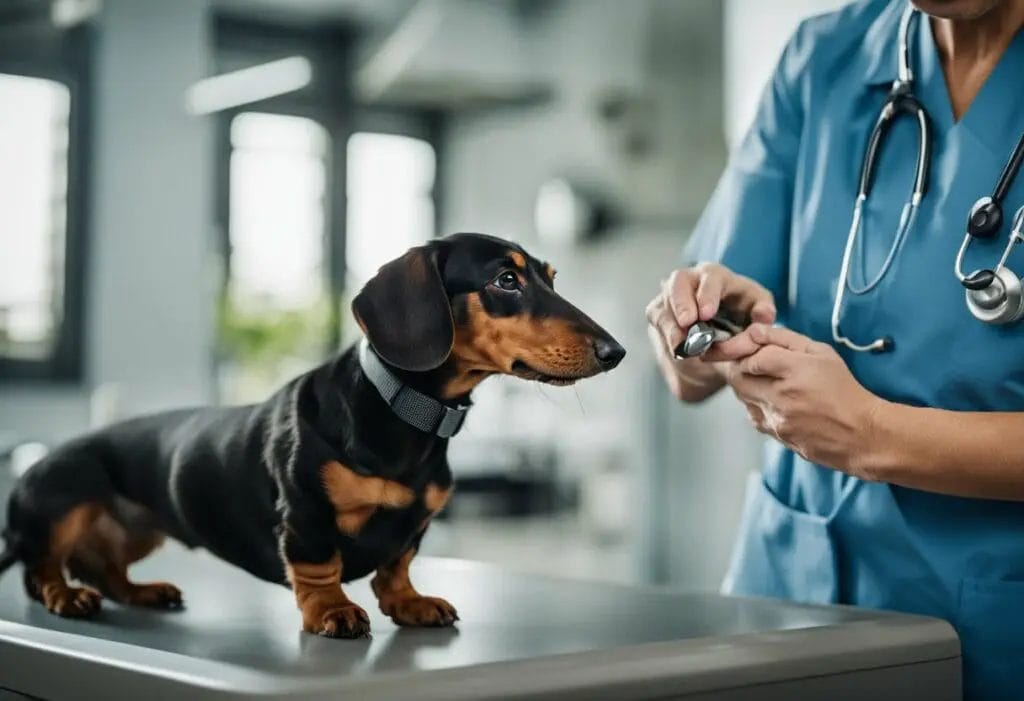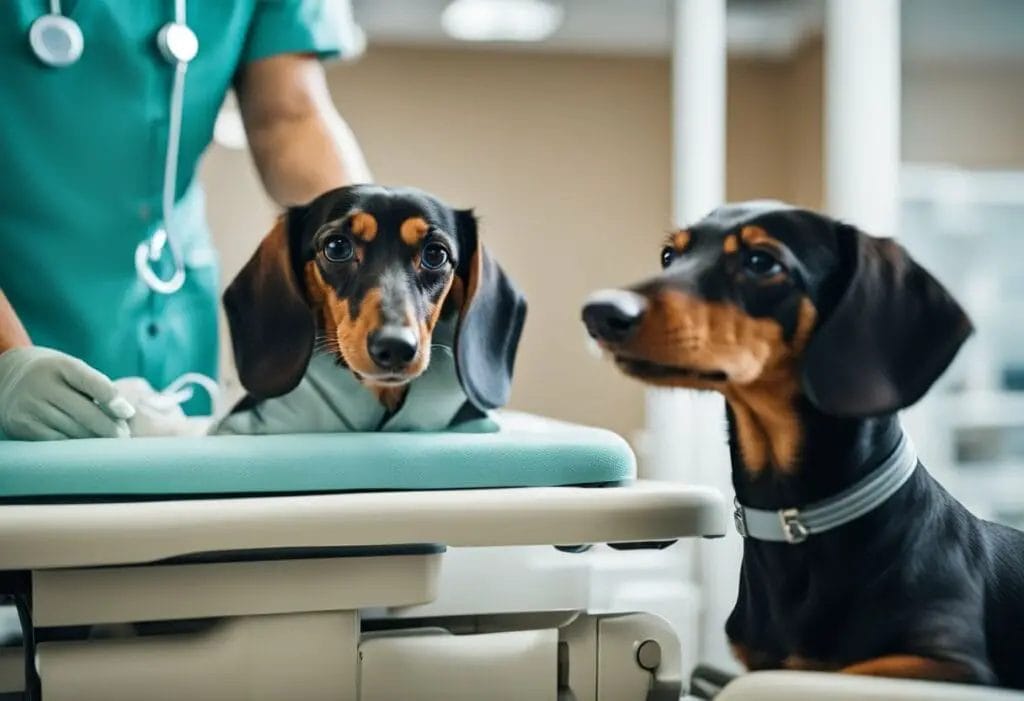Taking care of your Dachshund’s spine is essential to their overall health and wellbeing. Dachshunds are known for their long bodies and short legs, which can put them at risk for spinal issues such as intervertebral disc disease (IVDD). It’s important to be proactive in preventing these issues and knowing how to care for your Dachshund’s spine.

One way to care for your Dachshund’s spine is by managing their physical activities appropriately. High-impact actions, such as jumping on or off furniture, can be detrimental to their vulnerable backs.
Investing in ramps or pet steps for furniture access can minimize strain on their spine and reduce the risk of injury. Additionally, maintaining a healthy weight for your Dachshund can also help prevent spinal issues. Obesity can put excessive strain on the spine, leading to potential problems later in life.
Another crucial aspect of spine care for Dachshunds is being aware of the signs and symptoms of spinal issues such as IVDD. Symptoms include back pain, difficulty walking or standing, and paralysis. If you notice any of these symptoms, it’s important to seek veterinary care immediately.
Early detection and treatment can greatly improve your Dachshund’s chances of recovery. By being proactive and informed about spine care, you can help ensure your Dachshund lives a long, healthy life.
Understanding Dachshunds’ Unique Spine Structure
Dachshunds have a unique spinal structure that sets them apart from other dog breeds. Their long, narrow bodies are the result of an increased number of vertebrae, which leads to a curvature in the lower spine called kyphosis. This distinctive conformation puts additional strain on the Dachshund’s back and intervertebral discs compared to other breeds with more balanced proportions.
The Dachshund’s spine is an evolutionary adaptation for burrowing, but it comes with trade-offs. Their distinctive conformation increases the risk of disc degeneration and spinal injuries. The discs that act as cushions between the vertebrae can degenerate over time, losing their elasticity and becoming more susceptible to damage.
It is essential to take care of your Dachshund’s spine to prevent these issues. One way to care for your Dachshund’s spine is by managing their physical activities appropriately. High-impact actions, such as jumping on or off furniture, can be detrimental to their vulnerable backs. Investing in ramps or pet steps for furniture access can minimize strain on their spine and reduce the risk of injury.
Another cause of spinal issues in Dachshunds is excessive weight or obesity. Carrying extra pounds puts added stress on the spine and increases the likelihood of disc compression or rupture. It’s essential to keep your Dachshund at a healthy weight through proper diet and regular exercise.
Common Spinal Issues and Symptoms in Dachshunds
As an owner, it’s essential to be aware of the common spinal problems that can affect your furry friend. Here are some common spinal issues and symptoms in Dachshunds that you should look out for:
Intervertebral Disc Disease (IVDD)
IVDD is a common spinal issue in Dachshunds. This condition occurs when the cushioning discs between the vertebrae in the spine rupture or herniate, causing pressure on the spinal cord. This pressure can lead to pain, limping, stiffness, hunching, discomfort, and even paralysis in severe cases.
Signs of Back Pain
Dachshunds with back problems may show various signs of back pain. These signs include yelping or crying when picked up or touched, reluctance to move, dragging their back legs, trembling, or muscle spasms. If you notice any of these signs in your Dachshund, it’s essential to take them to the vet.
Back Injury
Dachshunds are prone to back injuries, especially if they jump or climb stairs frequently. A back injury can cause your dog to experience severe pain, limping, and difficulty moving.
Prevention Tips
To prevent spinal issues in your Dachshund, it’s essential to take some precautions. Avoid letting them jump from high places, such as beds or couches, and carry them up and downstairs instead. Additionally, maintain a healthy weight for your Dachshund to reduce the strain on their spine.
Preventing Spinal Problems in Dachshunds

Dachshunds are prone to spinal problems due to their long backs and short legs. As a Dachshund owner, there are several things you can do to prevent spinal problems in your furry friend.
Care and Prevention
One of the most important things you can do to prevent spinal problems in Dachshunds is to take care of their weight. Dachshunds that are overweight or obese are more likely to develop spinal problems. Feeding your Dachshund a healthy diet and providing regular exercise can help keep their weight in check.
Exercise
Regular exercise is essential for Dachshunds, but it’s important to choose low-impact exercises that won’t put too much strain on their spine. Walking is a great form of exercise for Dachshunds, and playing fetch can also be a fun way to get them moving. However, it’s important to avoid rough play and activities that involve jumping or climbing stairs.
Ramps and Baby Gates
Investing in ramps and baby gates can also help prevent spinal problems in Dachshunds. Ramps can be used to help your Dachshund get up and down from furniture without putting too much strain on their spine. Baby gates can be used to block off areas of your home that may be too difficult for your Dachshund to navigate.
Physical Activities
It’s important to monitor your Dachshund’s physical activities and limit activities that may be too strenuous for their spine. Rough play and activities that involve jumping or climbing stairs should be avoided. Instead, provide your Dachshund with low-impact activities that won’t put too much strain on their spine.
Recognizing and Responding to Back Pain in Dachshunds

As a Dachshund owner, it’s important to be aware of the warning signs of back pain in your furry friend. Back problems are common in Dachshunds due to their long backs and short legs, and can lead to serious health issues if not addressed promptly. Here are some things to look out for:
- Yelping or crying out in pain when picked up or touched
- Shivering or shaking, especially when accompanied by other symptoms
- Hiding or avoiding contact with family members
- Loss of appetite or reluctance to eat
- Difficulty moving or walking, such as wobbliness or limping
If you notice any of these symptoms, it’s important to take action immediately. Rest your Dachshund and limit their movement, and monitor their symptoms closely. If your dog is in severe pain or unable to move, seek emergency veterinary care right away.
When you take your Dachshund to the veterinarian, be sure to provide a detailed history of their symptoms and behavior. Your veterinarian may perform a physical exam and recommend further testing, such as x-rays or an MRI, to diagnose the problem.
Treatment for back problems in Dachshunds can vary depending on the severity of the issue. In some cases, rest and medication may be enough to manage the pain and promote healing. In more severe cases, surgery may be necessary to correct the problem and prevent further damage.
To prevent back problems in your Dachshund, it’s important to take steps to promote good spine health. This includes regular veterinary check-ups, maintaining a healthy weight, providing plenty of exercise, and avoiding activities that put excessive strain on the back, such as jumping or climbing stairs.
By staying vigilant and taking proactive steps to care for your Dachshund’s spine, you can help ensure they stay happy and healthy for years to come.
Treatment and Management of Spinal Issues in Dachshunds

Dachshunds are known to be prone to spinal issues, particularly intervertebral disc disease (IVDD). This condition can cause pain, discomfort, and even paralysis in your furry companion. If you suspect that your Dachshund is suffering from a spinal issue, it’s essential to seek veterinary care right away.
Treatment Options
The treatment options for spinal issues in Dachshunds depend on the severity of the condition. In mild cases, conservative management may be sufficient. This may include rest, anti-inflammatories, and pain relief medications. In more severe cases, surgery may be necessary to correct the problem.
Post-Operative Care
If your Dachshund has undergone spinal surgery, it’s essential to follow your veterinarian’s post-operative care instructions carefully. This may include limiting your dog’s activity level, providing pain relief medications, and physical therapy.
Assistive Devices
Assistive devices, such as ramps or pet steps, can be beneficial for Dachshunds with spinal issues. These devices can help your furry companion navigate furniture and stairs without putting undue strain on their vulnerable backs.
Physical Therapy
Physical therapy can be an effective way to manage spinal issues in Dachshunds. This may include exercises to strengthen your dog’s core muscles, as well as massage and stretching techniques.
Medications
Medications can be used to manage pain and inflammation associated with spinal issues in Dachshunds. Your veterinarian may prescribe anti-inflammatories or pain relief medications to help manage your furry companion’s discomfort.
Spinal issues can be a significant concern for Dachshunds. However, with proper treatment and management, your furry companion can live a happy, healthy life. If you suspect that your Dachshund is suffering from a spinal issue, it’s essential to seek veterinary care right away.
